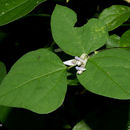en
names in breadcrumbs


Amphicarpaea bracteata (hog-peanut or ground bean) is an annual to perennial vine in the legume family, native to woodland, thickets, and moist slopes in eastern North America.[2]
Leaves have three leaflets and are held alternately on twining stems.
Flowers are pink to white and bloom from late summer to autumn. The flowers are either open for cross-pollination or closed and self-pollinating. The closed flowers may be above or below ground.[3]
Seeds from open flowers are held in a flat pod, pointed at both ends, that dries when mature and twists to release the seeds. Seeds from closed flowers are held in round pods with a single seed each. The roots and the cooked seeds from under the ground are edible.[4][5] The seeds which become subterranean from flowers on stolons give it the name peanut.[6]
This plant can be found in eastern North America, as well as further west into the Midwestern region, including Indiana,[6] Illinois,[6] and Wisconsin.[7]
Amphicarpaea bracteata (hog-peanut or ground bean) is an annual to perennial vine in the legume family, native to woodland, thickets, and moist slopes in eastern North America.
Amphicarpaea bracteata es una especie de planta trepadora anual o perenne perteneciente a la familia de las fabáceas, originaria de los bosques, matorrales y laderas húmedas del este de América del Norte y Asia oriental.[1]
Las hojas tienen tres foliolos y se encuentran alternativamente en tallos entrelazados. Las flores son de color rosa a blanco y florecen desde finales de verano a otoño. Las flores están bien abiertas para la polinización cruzada o cerradas para la auto-polinización. Las flores cerradas pueden estar por encima o por debajo del suelo.[2]
Las semillas de las flores abiertas se encuentran en una vaina plana, que se secan cuando maduran y dan giros para liberar las semillas. Las semillas de las flores cerradas se llevan a cabo en las vainas redondas con una sola semilla cada una. Las raíces y las semillas son comestibles.[3] Las semillas de las flores subterráneas tienen el nombre de maní.
Amphicarpaea bracteata fue descrita por (L.) Fernald y publicado en Rhodora 35(416): 276. 1933.[4]
Amphicarpaea bracteata es una especie de planta trepadora anual o perenne perteneciente a la familia de las fabáceas, originaria de los bosques, matorrales y laderas húmedas del este de América del Norte y Asia oriental.
Amphicarpaea bracteata là một loài thực vật có hoa trong họ Đậu. Loài này được (L.) Fernald miêu tả khoa học đầu tiên.[1]
Amphicarpaea bracteata là một loài thực vật có hoa trong họ Đậu. Loài này được (L.) Fernald miêu tả khoa học đầu tiên.